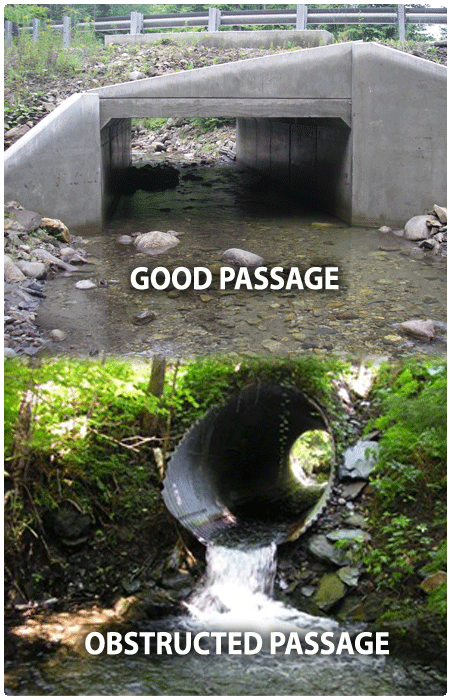Many of Vermont's existing stream crossings are barriers to movement of fish and wildlife.
 Improving stream crossing design and construction practices insure passage for Vermont’s fish and wildlife populations and improve flood resiliency.
Improving stream crossing design and construction practices insure passage for Vermont’s fish and wildlife populations and improve flood resiliency.
For reasons as simple as the need to escape extreme floods or as complex as maintaining genetic diversity, animals living in or along streams need to be able to move unimpeded through the watershed.
Here are several resources on stream crossings and aquatic organism passage that highlight the benefits of well-designed stream crossings and stream continuity.
Stream Crossings, Aquatic Organism Passage and Habitat Connectivity
-
The Vermont Stream Crossing Handbook
A user-friendly overview of stream/road crossing issues with links to additional technical assistance. -
Fish and Wildlife Conservation - Conserving Vermont's Natural Heritage
A guide to community-based planning for the conservation of Vermont's fish, wildlife and biodiversity. Vermont Fish & Wildlife Department.
Stream Crossing Design Guidelines and Resources
-
The Vermont Stream Crossing Handbook
A user-friendly overview of stream/road crossing issues with links to additional technical assistance. -
Guidelines for the Design of Stream/Road Crossings for Passage of Aquatic Organisms in Vermont
A technical document providing biological and engineering design guidance for new, replacement stream/road crossings and repairs in Vermont. -
Aquatic Organism Passage Treatment Sketches
A compilation of diagrams for common Aquatic Organism Passage design approaches that may be useful for developing project plans. -
Stream Simulation: An Ecological Approach to Providing Passage for Aquatic Organisms at Road-Stream Crossings
A comprehensive U.S. Forest Service publication detailing the stream simulation approach to designing stream crossings
Technical Assistance for Stream Crossing Design and Construction
-
Vermont Department of Environmental Conservation (VDEC)
Check here for current information on stream crossings including specific regulation requirements, permit applications, and Stream Alteration Engineer contacts. -
VDFW District Fish Biologists
Contact a department fish biologist to identify aquatic resource issues associated with a specific stream crossing project.
State and Federal Regulations for Stream Crossings and Aquatic Organism Passage
This list includes regulations that relate to stream crossing structures and aquatic organism passage in Vermont. Other local municipal regulations may also apply.
Vermont ANR Culvert Assessment Protocols, Screening Tools and Geomorphic Assessments
-
Vermont Culvert Aquatic Organism Screening Tool
This report describes the ANR culvert inventory measures and metrics used to identify potential AOP enhancement projects. -
Vermont Culvert Geomorphic Compatibility Screening Tool
This report describes the ANR culvert inventory measures and metrics used to identify stream crossing structures at risk for failure due to incompatibility with natural stream processes. -
Vermont Bridge and Culvert Assessment
This report describes the protocol for assessing stream crossing structures for AOP and geomorphic compatibility. -
Vermont Stream Geomorphic Assessment Protocols (VTANR)
Protocols for stream measures required for AOP analysis and design. -
ANR Natural Resources Atlas
This mapping tool displays detailed information for the thousands of culvert assessments that have been conducted in Vermont. To access the information, go to the “Map Layers,” expand the Fish and Wildlife layer and select “Stream Crossings.”
Identifying and Implementing Aquatic Organism Passage Enhancement Projects in Vermont
-
Implementing AOP Enhancement Projects in Vermont
The process for the identification, design and implementation of AOP enhancement projects in Vermont. -
Examples of AOP Retrofit Designs
For other questions about aquatic organism passage at stream crossings contact Will Eldridge, Aquatic Habitat Biologist, VFWD (william.eldridge@vermont.gov /(802) 485-7566)
